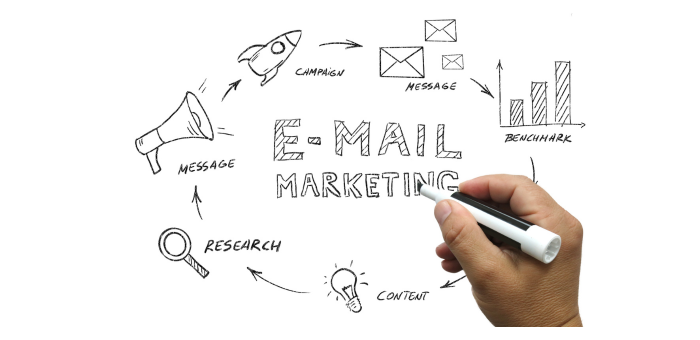The Ultimate Guide to Choosing and Implementing the Perfect Email Marketing Solution Part Two
Continuing from The Ultimate Guide to Choosing and Implementing The Perfect Email Marketing Solution Part One
Setting up your email marketing campaigns is a crucial step in effectively reaching and engaging your audience. With the right strategy and tools in place, you can create personalized and impactful email campaigns that drive results.
First, you need to choose a reliable email marketing solution that aligns with your business needs. Look for a platform that offers a user-friendly interface, advanced automation features, customizable templates, and robust analytics. Consider your budget, list size, and desired level of automation when making your decision.
Once you’ve selected your email marketing solution, it’s time to set up your campaigns. Start by defining your goals and target audience. What do you want to achieve with your emails? Are you trying to drive sales, generate leads, or nurture customer relationships? Understanding your objectives will help you tailor your content and design.
Next, create a captivating subject line that grabs attention and entices recipients to open your emails. Keep it concise, clear, and compelling. Experiment with different subject lines to see what resonates best with your audience.
Craft engaging and relevant content that provides value to your subscribers. Whether it’s informative articles, product updates, or exclusive offers, make sure your content is tailored to your audience’s interests and preferences. Use a mix of text, images, and calls-to-action to make your emails visually appealing and interactive.
Segment your email list based on demographics, purchase history, or engagement levels to deliver targeted messages that resonate with each subgroup. Personalization is key to building strong relationships and increasing conversions.
Don’t forget to optimize your emails for mobile devices. With the majority of people checking their emails on smartphones, it’s essential to ensure your emails are mobile-friendly and easily readable on smaller screens.
Finally, track and analyze the performance of your email campaigns using the analytics provided by your email marketing solution. Pay attention to metrics such as open rates, click-through rates, and conversions to evaluate the effectiveness of your campaigns. Use this data to refine your strategies and improve future campaigns.
By following these steps and investing time and effort into setting up your email marketing campaigns, you’ll be on your way to building a successful and impactful email marketing strategy that drives engagement, conversions, and customer loyalty.
Designing compelling email marketing templates and content

When it comes to email marketing, the design and content of your emails play a crucial role in grabbing the attention of your subscribers and enticing them to take action. A well-designed email template can make a lasting impression and increase engagement with your audience. Here are some tips to help you create compelling email templates and content:
1. Keep it visually appealing: Use a clean and professional design that aligns with your brand identity. Incorporate eye-catching visuals, such as high-quality images and relevant graphics, to make your emails visually appealing.
2. Use a responsive design: With the increasing use of mobile devices, it’s essential to ensure that your email templates are responsive and can adapt to different screen sizes. This will guarantee that your subscribers have a seamless experience regardless of the device they are using.
3. Craft compelling subject lines: Your subject line is the first thing recipients see in their inbox, so make it enticing and relevant. Use power words, personalization, and a sense of urgency to grab their attention and encourage them to open your email.
4. Focus on clear and concise content: Keep your email content concise and easy to read. Use short paragraphs, bullet points, and subheadings to break up the text and make it scannable. Highlight the key message or offer to ensure it stands out.
5. Personalize your emails: Address your subscribers by their names and use personalization tokens to make your emails feel more tailored to each recipient. Personalization can significantly increase engagement and make your subscribers feel valued.
6. Include a strong call-to-action (CTA): Every email should have a clear and compelling CTA that prompts subscribers to take the desired action, such as making a purchase, signing up for an event, or downloading a resource. Use contrasting colors and persuasive language to make your CTAs stand out.
7. Test and optimize: Continuously test different elements of your email templates, including subject lines, content length, visuals, and CTAs. Use A/B testing to compare different versions and identify what resonates best with your audience. Analyze the data and optimize your emails based on the results.
Remember, the aim is to create emails that not only capture attention but also provide value to your subscribers. By designing visually appealing templates, crafting compelling content, and optimizing your emails based on data-driven insights, you can create email campaigns that drive engagement, conversions, and long-term customer loyalty.
Tracking and analyzing email marketing performance

Tracking and analyzing the performance of your email marketing campaigns is crucial for optimizing your strategies and achieving the best possible results. By monitoring various metrics and analyzing the data, you can gain valuable insights into your audience’s behavior and preferences, allowing you to refine your approach and tailor your content to their needs.
One of the key metrics to track is the open rate, which indicates the percentage of recipients who opened your email. A high open rate suggests that your subject lines are compelling and enticing enough to capture the attention of your subscribers. On the other hand, a low open rate may indicate that you need to work on improving your subject lines or the timing of your emails.
Click-through rate is another essential metric to consider. It measures the percentage of recipients who clicked on a link within your email, indicating their engagement and interest in your content. A high click-through rate signifies that your email content is engaging and effectively drives traffic to your website or landing page.
Conversion rate is perhaps the most significant metric, as it tracks the number of recipients who took the desired action after clicking on a link in your email. This could be making a purchase, signing up for a newsletter, or filling out a form. By analyzing the conversion rate, you can determine the effectiveness of your email campaigns in driving desired outcomes.
Aside from these core metrics, it’s also important to track other relevant data points, such as bounce rate, unsubscribe rate, and email sharing/forwarding rate. These metrics provide insights into the quality of your email list, the relevance of your content, and the potential for word-of-mouth marketing.
To track and analyze these metrics, it’s essential to choose an email marketing solution that offers robust reporting and analytics features. Look for a platform that provides comprehensive data on key performance indicators, allows you to segment your audience for more targeted analysis, and offers easy-to-understand visualizations and reports.
By diligently tracking and analyzing email marketing performance, you can continuously optimize your campaigns, identify areas for improvement, and ultimately achieve greater success in reaching and engaging your audience.
Best practices for successful email marketing campaigns

Successful email marketing campaigns require careful planning and adherence to best practices. Here are some key tips to ensure your email marketing efforts yield the best results:
1. Build a targeted and segmented email list: Instead of sending generic emails to a broad audience, segment your email list based on demographics, preferences, and behavior. This allows you to send personalized and relevant content, increasing the chances of engagement and conversion.
2. Craft compelling subject lines: The subject line is the first impression your email makes, so make it count. Use attention-grabbing, concise, and enticing subject lines that compel recipients to open your emails.
3. Create engaging content: Deliver value to your subscribers by providing informative and engaging content. Use a mix of educational, promotional, and entertaining content to keep your audience interested and eager to open your emails.
4. Optimize for mobile devices: With the majority of people reading emails on their mobile devices, it’s crucial to ensure your emails are mobile-friendly. Use responsive email templates, use legible fonts, and design with a mobile-first mindset.
5. Personalize your emails: Address your subscribers by their names and tailor the content to their preferences whenever possible. Personalization makes your emails feel more relevant and increases the likelihood of engagement.
6. Use compelling visuals: Incorporate visually appealing images, videos, and graphics in your emails to catch the reader’s attention and enhance the overall aesthetic appeal. Visuals can help convey your message more effectively and leave a lasting impression.
7. Include clear and prominent calls-to-action (CTAs): Guide your subscribers towards the desired action by including clear CTAs in your emails. Use action-oriented language and make the CTA buttons prominent and enticing.
8. Test and optimize: Continuously test different elements of your email campaigns, such as subject lines, content, CTAs, and send times. Analyze the results and optimize your campaigns based on the insights gained to improve open rates, click-through rates, and conversions.
9. Maintain a consistent sending schedule: Establish a consistent sending schedule to maintain engagement with your subscribers. Whether it’s weekly, bi-weekly, or monthly, sticking to a predictable schedule helps build anticipation and keeps your brand top of mind.
10. Monitor and analyze metrics: Regularly track and analyze key email marketing metrics like open rates, click-through rates, and conversions. This data provides valuable insights into the effectiveness of your campaigns and helps you refine your strategies.
By following these best practices, you can maximize the impact of your email marketing campaigns, strengthen customer relationships, and drive desired actions from your subscribers.
Tips for maintaining a healthy email list and ensuring compliance

Maintaining a healthy email list is crucial for successful email marketing campaigns. It not only ensures that your messages reach the right audience but also helps you comply with various regulations such as the General Data Protection Regulation (GDPR) and the CAN-SPAM Act.
First and foremost, make sure to regularly clean your email list by removing inactive or bounced email addresses. These addresses not only contribute to a poor engagement rate but can also affect your deliverability. Use email verification tools to identify and remove invalid or fake email addresses. This will help you maintain a clean and active subscriber list.
Another tip is to provide clear and transparent opt-in and opt-out processes. When collecting email addresses, always obtain explicit consent from your subscribers and inform them about the type of content they will receive. Offer an easy and straightforward way for subscribers to unsubscribe from your emails if they no longer wish to receive them. This demonstrates your commitment to respecting their preferences and helps you stay compliant with email marketing regulations.
Segmenting your email list is also essential for maintaining its health. By categorizing your subscribers based on their interests, demographics, or purchasing behavior, you can send targeted and relevant content to each segment. This not only improves engagement but also reduces the chances of subscribers marking your emails as spam.
Regularly monitor and analyze your email campaign metrics to identify any potential red flags. High bounce rates, low open rates, and increased spam complaints can indicate issues with your email list. Take immediate action to resolve any problems and ensure that your email list remains healthy and engaged.
Lastly, staying informed about email marketing regulations and best practices is crucial. Keep up to date with changes in privacy laws and email marketing guidelines to ensure your compliance. Implement strong data protection measures and maintain a clear understanding of how your subscribers’ data is collected, stored, and used.
By following these tips, you can maintain a healthy email list, enhance your email marketing efforts, and ensure compliance with relevant regulations.
Troubleshooting common email marketing challenges

Email marketing can be an incredibly powerful tool for businesses, but it’s not without its challenges. In this section, we’ll explore some common email marketing challenges and provide practical troubleshooting tips to help you overcome them.
1. Low open rates: One of the most common challenges in email marketing is getting your subscribers to actually open and read your emails. To troubleshoot this, consider optimizing your subject lines to be more compelling and engaging. Personalization and using curiosity or urgency can also help increase open rates.
2. High unsubscribe rates: If you’re experiencing a high number of unsubscribes, it’s important to evaluate the content and frequency of your emails. Are you providing value to your subscribers? Ensure that your emails are relevant, informative, and not overly promotional. You may also want to segment your email list to deliver more targeted content to specific groups.
3. Deliverability issues: Sometimes, emails end up in the spam folder or don’t get delivered at all. To troubleshoot this, make sure you’re following email best practices such as using a reputable email service provider, authenticating your domain, and managing your email list to remove inactive or invalid addresses. Regularly monitor your email deliverability and address any issues promptly.
4. Design and formatting problems: Your emails should be visually appealing and mobile-friendly. If you’re facing design or formatting challenges, ensure that your email templates are responsive and optimized for different devices. Test your emails across various email clients and devices to make sure they render correctly.
5. Lack of engagement: If your subscribers aren’t engaging with your emails, it’s time to assess your content strategy. Are you providing valuable and relevant content? Consider conducting surveys or analyzing customer feedback to understand their preferences and interests better. Experiment with different types of content such as educational articles, product updates, or exclusive offers to increase engagement.
6. Tracking and analytics issues: Accurate tracking and analytics are essential to measure the success of your email marketing campaigns. If you’re facing challenges in this area, double-check that your tracking codes are correctly implemented, and ensure that you’re using the right analytics tools. Regularly review your email metrics to identify areas for improvement and optimize your campaigns accordingly.
By troubleshooting these common email marketing challenges, you can refine your strategies and achieve better results. Remember, email marketing is an ongoing process, so continuously monitor and adapt your approach to meet the evolving needs of your subscribers.
Maximizing the ROI of your email marketing efforts

Maximizing the return on investment (ROI) of your email marketing efforts is crucial to the success of your overall marketing strategy. After all, you want to ensure that the time, effort, and resources you invest in email marketing generate the highest possible returns for your business.
To maximize ROI, it’s important to focus on several key areas. First and foremost, make sure you have a well-defined and targeted email list. Building a quality list of engaged subscribers who are genuinely interested in your offerings will significantly increase the likelihood of conversions.
Segmentation is another essential factor in maximizing your ROI. By dividing your email list into smaller, more specific groups based on demographics, interests, or past purchasing behavior, you can tailor your email content to resonate with each segment. This personalized approach increases engagement and conversion rates, ultimately driving higher ROI.
Crafting compelling and attention-grabbing email content is equally vital. Your emails should be visually appealing, easy to read, and contain valuable and relevant information. Incorporate persuasive call-to-action buttons and links that direct recipients to specific landing pages or product pages to encourage conversions.
Regularly testing and analyzing your email campaigns is crucial to ongoing improvement. Conduct A/B testing on subject lines, email designs, and calls-to-action to identify what resonates best with your audience. Analyze open rates, click-through rates, and conversion rates to gain insights into the effectiveness of your campaigns and make data-driven decisions for optimization.
Lastly, don’t forget to continuously optimize your email marketing strategy. Monitor industry trends, stay updated on best practices, and adapt your approach accordingly. As consumer behaviors and preferences evolve, it’s essential to stay ahead of the curve and deliver emails that truly resonate with your audience.
By implementing these strategies and continuously refining your email marketing efforts, you can maximize your ROI and achieve long-term success with your email campaigns. Remember, email marketing is a powerful tool when leveraged effectively, so invest the time and effort to make it an integral part of your marketing strategy.
Conclusion: Choosing the right email marketing solution for your business

In conclusion, choosing the right email marketing solution for your business is a critical decision that can greatly impact the success of your email marketing campaigns. With so many options available in the market, it’s important to carefully evaluate your specific needs and consider various factors before making a final decision.
Start by clearly defining your goals and objectives for email marketing. Are you looking to increase sales, nurture leads, or build customer loyalty? Understanding your desired outcomes will help you determine the features and functionalities you need in an email marketing solution.
Next, consider your budget and resources. Different solutions come with different price points and levels of complexity. It’s important to choose a solution that aligns with your budget and the level of expertise your team possesses. Some solutions offer user-friendly interfaces and pre-designed templates, while others may require coding knowledge and customization.
Evaluate the scalability of the solution. As your business grows, your email marketing needs may evolve as well. It’s important to choose a solution that can accommodate your future growth and provide room for expanding your email marketing efforts.
Additionally, consider the integration capabilities of the solution. If you already have other marketing tools or customer relationship management systems in place, it’s crucial to choose an email marketing solution that seamlessly integrates with your existing infrastructure. This will allow for smoother data transfer and more efficient workflows.
Lastly, take advantage of free trials and demos offered by email marketing solution providers. This will give you the opportunity to test drive the platform and assess its user-friendliness, features, and overall compatibility with your business needs.
By carefully considering these factors and conducting thorough research, you can confidently choose and implement the perfect email marketing solution for your business. Remember, the right solution will not only streamline your email marketing efforts but also help you engage and connect with your audience in a meaningful way, leading to increased conversions and long-term success.
We hope you found our ultimate guide to choosing and implementing the perfect email marketing solution helpful and informative. Email marketing is a powerful tool for businesses of all sizes, and selecting the right solution can make all the difference in reaching your marketing goals. By following the steps outlined in this guide, you can confidently choose an email marketing platform that suits your needs and seamlessly integrate it into your marketing strategy. Happy emailing!